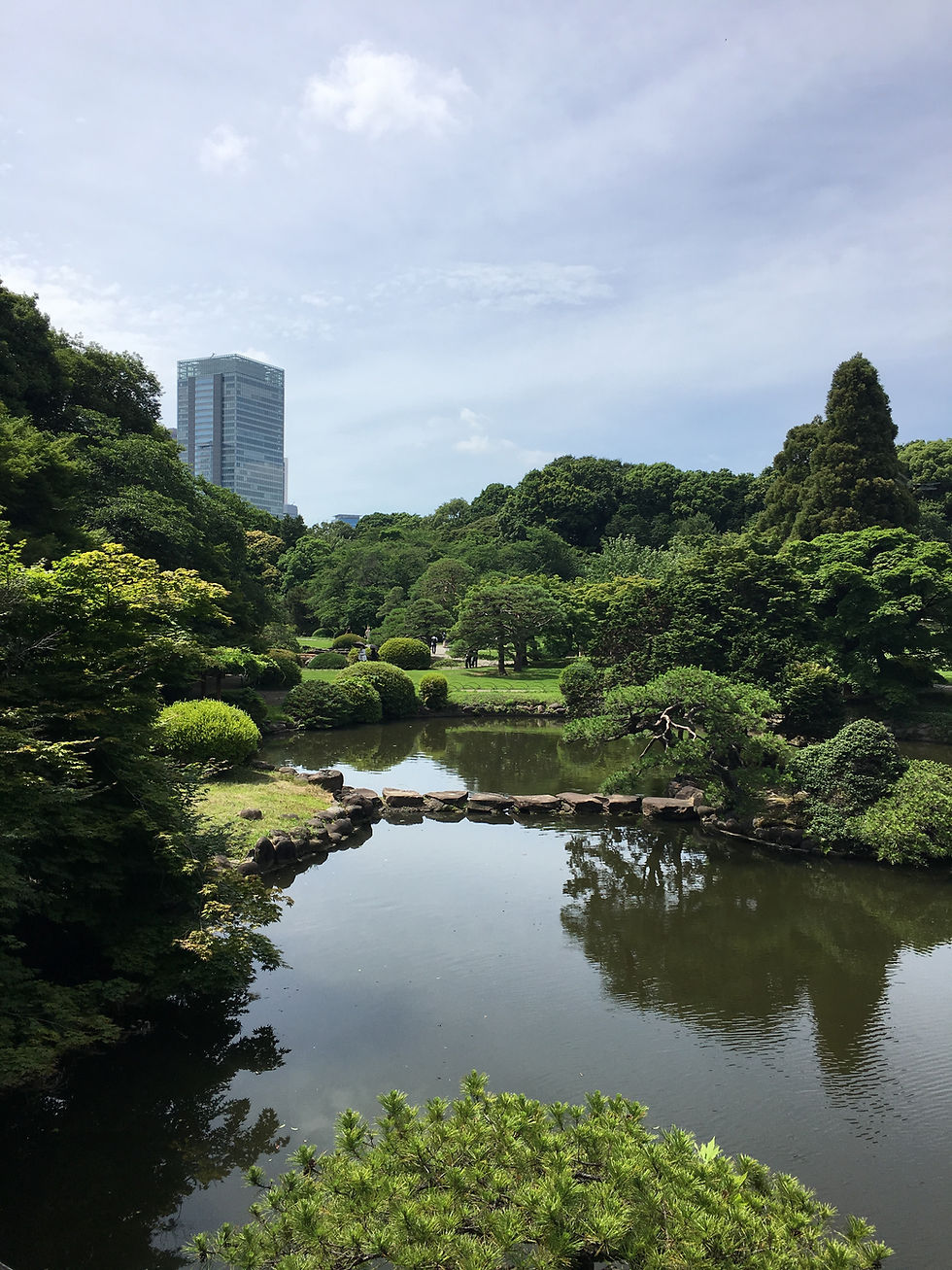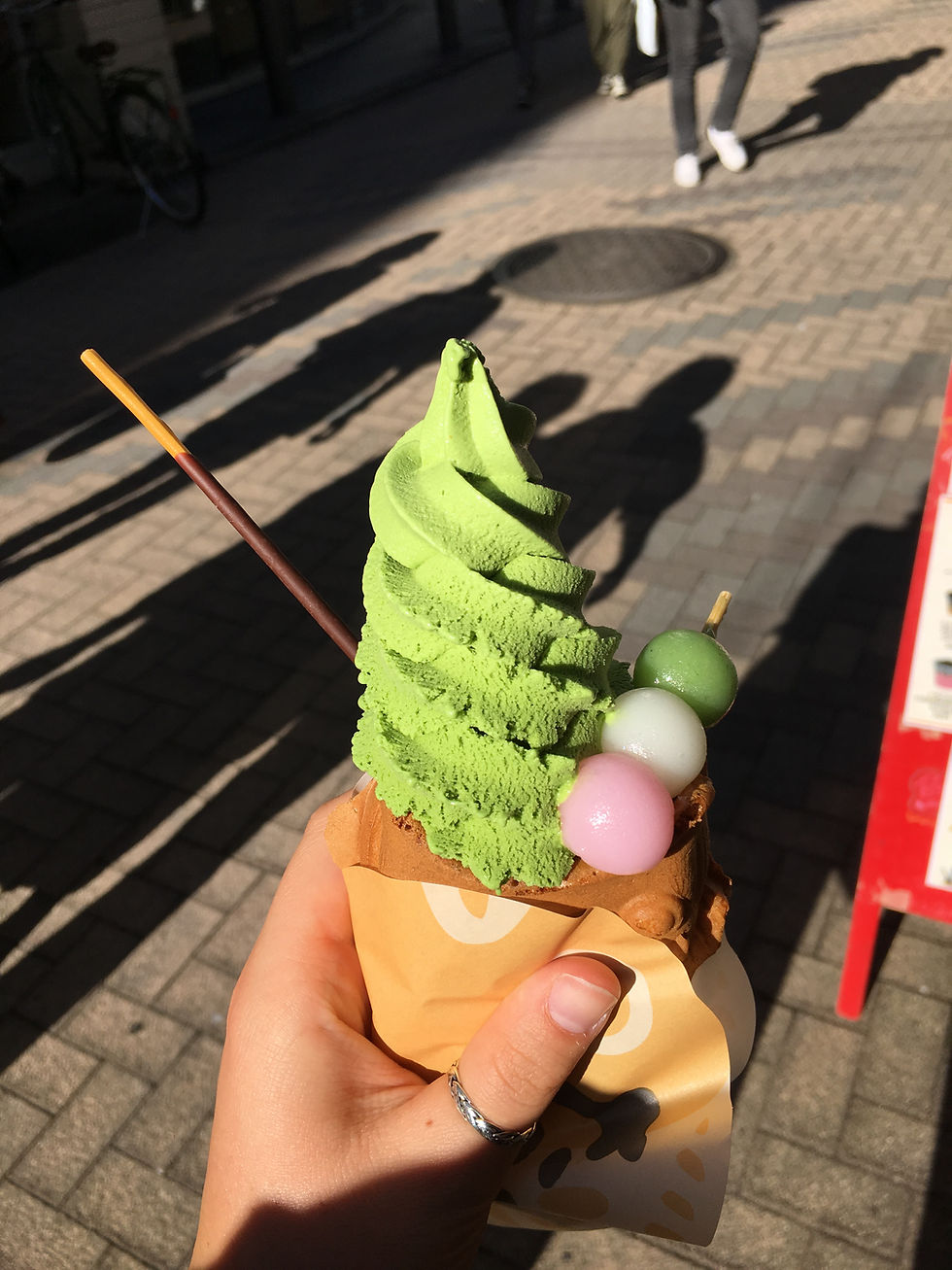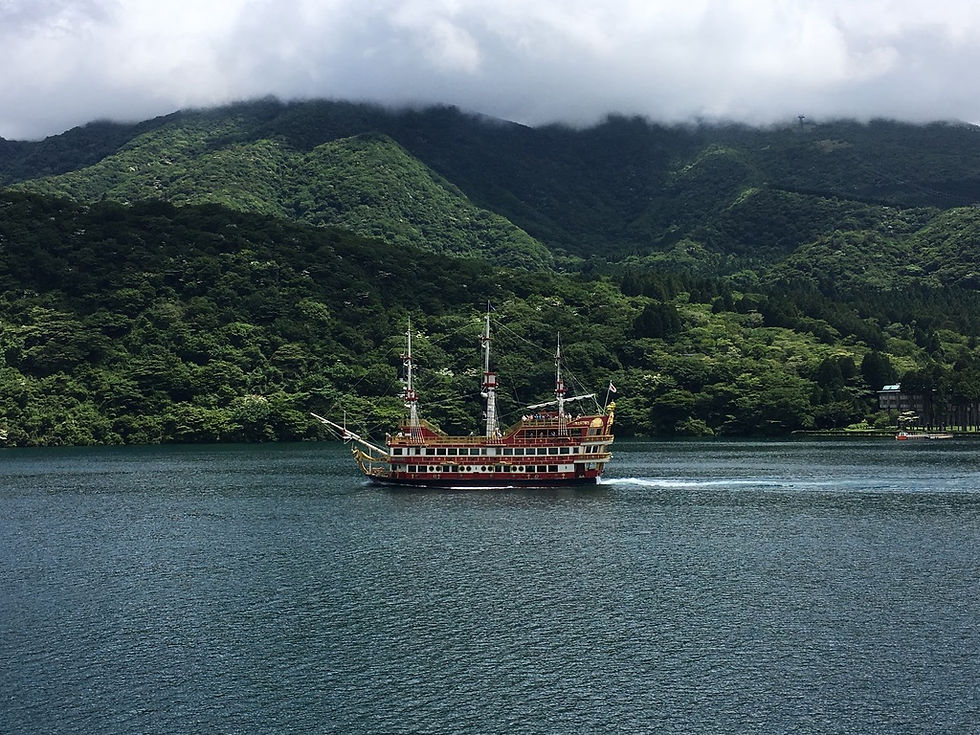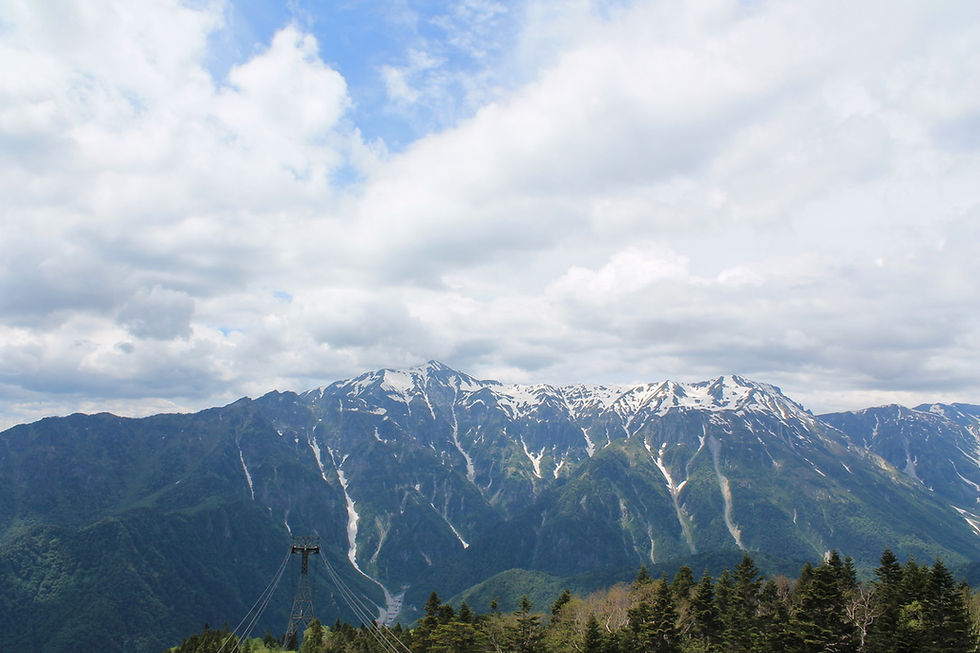Jetting around Japan
- Sophie Hazel

- Jul 3, 2020
- 13 min read
In a world that’s becoming more and more interconnected in every way, it’s difficult to find a holiday destination so completely different in culture and language from your own. So, in search of this ‘different’, my family settled on Japan for our summer trip. I’d never really considered it before but it was cropping up more and more on Instagram and Facebook as the hosts of the 2019 rugby world cup and the 2020 Olympic games. Now seemed like the perfect time to explore before all the tourists got wind!
We landed at lunchtime and I was immediately struck by the efficiency and cleanliness of the airport. However, what stood out most of all was the signs in Japanese. Although there was English written underneath, it was totally surreal to see a language where you couldn’t even begin to make out the symbols, all the letters impossible to recognise. Having breezed through border control and picked up our baggage easily, our total lack of understanding the language didn’t seem to be a problem until we reached the subway. Then, all the English disappeared as we quite literally were in the thick of it. We had no access to data and absolutely no way of decoding all the symbols pointing to destinations and platforms. For a family who, between them, can get around with English, Norwegian (and therefore Swedish and Danish), French, a smattering of German and Spanish, a few words of Portuguese and even some Swahili, this was most definitely a shock. Huge suitcases on our backs, we questioned anyone who looked like they might speak English about how to get to Asakusa. We eventually figured it out via broken English, zero Japanese and glimpses of subway wifi.
Next hurdle: one thing no one warns you about is the plethora of entrances and exits of each station. It’s like a huge crossroads every time you want to leave, dodging commuters and families and groups of teenagers with eyes glued to their phones (sound familiar Londoners?). Having left through the wrong exit, we hiked all the way to our hotel forgetting that Japan is actually quite hot and I’d already sweated through all my clothes. Relieved to reach the hotel, we dumped our bags and headed off in search of the famous Shibuya crossing: the busiest intersection in the world. After once again battling with the subway, we sat in an extraordinarily clean carriage for an hour all the way. When we reached the crossing, it was like Times Square on steroids: billboards and people are far as the eye could see. The only way to describe it is pure craziness. We wandered the streets, endlessly excited by all the lights and music and crowds. After a craft beer in an underground pub, we spotted a vending machine restaurant for dinner. Selecting which ramen we wanted from the machine, we paid and took the ticket inside to hand to the chef. After a short wait, the most delicious ramen and dumplings arrived. It was bizarre and yet incredibly efficient. Why not cut out the middle man?

The next morning Pappa, Bastian and I headed off early to find breakfast. We settled on a cute café in a side street but coffee shops here seem to sell, well, coffee. Nothing else. Suitably-caffeinated, we set off to explore another district: Shinbuja. First stop was the Government Metropolitan Building where we took the elevator to the South Observatory and saw the whole of Tokyo from the 45th floor. We even saw Mount Fuji! We then walked to Shinbua Gyoen (the big gardens) and wandered around the well-manicured lawns, stunning trees and beautiful flowers, interspersed with old-fashioned tea rooms. En route to the Samurai museum, we walked through the Golden Gai; a street filled with tiny bars, each seating only about 5 or 6 people at a time. After the museum, a change of scene as we headed into the ‘Red Light District’, filled with flashing lights, a robot restaurant and even a giant Godzilla statue. The whole place was surreal; a completely different world. In an attempt to be adventurous, we had dinner at Hoppy-Duri – the street food street – where we all tried a little bit of everything. Pappa was not keen on the tempura eel or the tempura prawn head (including eyes, legs and all the shell at no extra cost!) and so, embarrassed at his inability to keep it down, we made a swift and giggling exit before trying to navigate our way back to the hotel.

After a delicious brunch at Suke 6 Diner, we took the metro to Ginza and walked through the glitzy fashion streets towards the not-so-glitzy fish market. The morning chaos had calmed and it was full of people hungry for the freshest fish, sushi and even oysters you could imagine! There was also matcha-flavoured anything, bizarre kitchen utensils and frozen fruit. Fed up of fish, we walked to the Hamarikyu Gardens – another beautiful area of greenery nestled amidst the grey skyscrapers. The sun beating down, we took refuge in the tea house and had matcha tea sitting on a mat in a traditional building. A quick walk around the Imperial Palace garden, some matcha ice creams and a (rather disappointing) Godzilla statue later, we got ready for our food tour.

Our first stop was beer and breaded ham cutlet under the railway tracks, followed by rice crackers at a speciality shop while watching a video on their production. Next, skewers of chicken, beef and tuna with a sweet egg and udon noodles without broth. The penultimate stop was full of food with vegetables and miso paste, their famous fried chicken (are we sure this is a Japanese food tour?), charcoal chicken, seared tuna wrapped in nori, shrimp and edamame pizza, rice wrapped bacon, dumplings and yaki soba. Pappa, Bastian and I even tried raw chicken! To cap it all off, dessert was a street stand where we had a fish-shaped pastry filled with red bean paste or custard. Full and tired from all the walking, we had a night-cap before making our way back to the hotel.

A greyer day but filled with colour by our visit to the amazing Senso-Ji Temple! It was huge and beautiful and red but buzzing with both tourists and worshippers. It was incredible to see the grandeur of the temple and garden. Walking through many strange food and souvenir stands, we stumbled across a huge food festival with music playing in the Ueno area. Trying to add some sunshine to the rain, we drank mojitos at 11am listening to South American beats – yep, definitely what you’d expect on our Japanese adventure. Deciding that pandas didn’t deserve an 80-minute queue (if you met my mother, you’d realise that patience is not our family’s strong suit), we hit up the Tokyo National Museum. I tried my hand at some Japanese calligraphy while the others wandered around the artefacts. With heavier rain, the 50-minute panda queue didn’t seem so bad.

Pappa held our spot while Bastian and I zipped round to see the elephants, lion, tiger, gorillas and bears. We joined him back in the queue and followed the conveyor belt crowd to try and gape at a panda. They looked exactly as you’d imagine; almost cartoon-like and completely different from any animal I’d seen before. Dinner was very adventurous as we were taken out for sushi by an old work colleague of Pappa’s. Note to self: Japanese food in Japan is slightly different to Japanese food in an European restaurant, surprisingly. Starting with sashimi and then moving onto sushi plates, we ate tuna, salmon, raw squid, eel, sea urchin (definitely would not recommend), salmon roe, herring roe, fried puffer fish, raw prawn and then the weirdly-sweet egg all washed down with lots of beer, green tea and sake. Definitely a pretty amazing experience!
Today we were leaving the city! The train we were taking, from Tokyo to Hakone, was the same one that three people had been stabbed on yesterday morning – reassuring stuff right there. A short journey on the bullet train followed by a confusing change onto the bus. The bus ride winding through the hills was beautiful, surrounding by hills and glimpses every now and then of waterfalls. We arrived in the pouring rain so we explored the Onsen in the hotel. I sat on a stool to wash my hair and then relaxed in the hot springs outside. Once the rain had cleared, we wandered around the town. Then, for dinner, we got into our kimonos and walked into the central room to a huge display of sushi, tempura, miso soup, broth and noodles.

We spent the next day on a huge pirate ship – an odd platform for a lake cruise – surrounded by hills that make you want to burst into song. However, the one thing I wanted to see was still buried in thick clouds: Mount Fuji. We patiently crossed from one side to the other, praying for the sky to clear but still no great mountain. Instead, we bought some postcards of it from the gift shop and then collected our luggage and headed back to the train station. Our journey to Kyoto was short but sweet on the Shinkansen and we walked to our hotel located in the heart of the city, right next to the river. We dropped off our stuff, recovered from the travelling and then set out for more tourist stuff. First stop was Ponte-Cho, a quaint, pedestrian-only street. It was like we’d gone back in time, meandering through small, wooden houses that crowded the alley. It was just over half a kilometre in length, with the bustling city on one side and the peaceful river on the other. Kyoto turned out to be my favourite city, with our exploration of temples and walking through the Fushimi Inari Shrine. The gates are a glowing vermillion and are supposed to represent the transition between our everyday worlds and the divine world.


Hiroshima was so quiet compared to the cities we’d visited so far. A city recovering from tragedy through its focus on peace. The A-Bomb Dome stood at the centre, a constant reminder of the town’s history. It had an eerie quality, as if it was reminding the town that, even though it had been rebuilt, it had not recovered. We walked around all the surrounding monuments and then entered the Peace museum. The exhibition was detailed and it was interesting to read about the events leading up to the dropping of the bomb and its effects. The facts were difficult to digest but the emotional element of the exhibition – children’s accounts of the 6th of August, the clothes people were wearing when they died, photographs – portrayed a story that no one could imagine. In one room, a young boy recounts the details of the day alongside drawings and, through the simplistic, child-like words, it is hard to escape the sheer horror of the event. The tranquillity of the town seems to be a nod to its mission for peace, their silent plea for there never to be another Hiroshima. From our high hotel room, we could see the whole town laid at our feet, even extending beyond to the islands in the distance and the golden beaches that looks dreamy in the sunshine. Our dinner was a traditional meal of ‘Okonomiyaki’ – the local speciality. We found one of the restaurants that the hotel had recommended (Benbei) and were led to a booth where the table was a huge hot plate. The whole room was steaming and we quickly understood that everyone had a hot place in order to keep the food warm while you were eating it. We ordered four of the standard okonomiyaki and watched the chefs pile on the cabbage and make these strange pancakes at the front of the restaurant. They brought them over and put them on the hotplate, giving us chopsticks and mini scrapers with which to eat them. Ladies and gentlemen, may I present my favourite dish in Japan until this point. Crispy noodles, bacon, egg and cabbage. All layered in a giant pancake. Delicious!

An overcrowded train ride later and we arrived in Osaka, dropped off bags at the hotel and then set out to explore Osaka castle. We bought lunch from the highly recommended ‘Goût’ bakery and then ate it in the castle gardens – felt just like summers in Sussex! We wandered around the lawns, stumbling across what seemed to be a shopping mall in the middle, next to the castle. It was very bizarre. My first taste of Kobe meat for dinner that evening! It was absolutely delicious. Having finished, we walked around the crazy streets of Dontonburi, marvelling at all the billboards, people and strange models of seafood outside the restaurants. It was Saturday night and this definitely seemed to be the place to be.
The next day brought another early start as we took the train to Nara and then rented electric bikes (we were on holiday!) and enjoyed the ease of climbing hills when not powered by your own legs! The city was beautiful with a huge park full of temples. We zig-zagged between all of them, stopping for quick pictures and popping into a temple every now and then. We saw the biggest Buddha in the world, completely made of bronze, which was just magnificent. The deer also seemed to be zig-zagging amongst tourists, eating anything they could get their teeth on. We cycled through the forests and picnicked on benches, again just like summers at home.
Well, this day brought more than just an early start. Standing in the cubicle shower, the whole room began to shake. At first, I thought it was Bastian playing some kind of prank but the shaking continued to I rushed out to see him staring outside the window. We’d been in an earthquake. Follow that, there were lots of announcements on speakers around the hotel and we all received an emergency alert on our phones. All this was in Japanese so we still had no idea what was going on! We quickly got ready, packed our bags and then jumped in the car to get out of Osaka. Having set off reasonably early, we drove around for two hours before ending up back where we started. We stopped and asked for help at the car rental as the sat nav seemed to make us drive around in circles. They explained that, because of the earthquake, the highway was closed, which was our way out of Osaka. We finally set off again just to be stuck in countless traffic jams, dodging all the blocked roads and with no idea of any road updates or anything that was going on. We weren’t sure whether to stay another night or push through, and none of us has data so couldn’t even check the news. After several hours, we finally made it out of Osaka, out of Kobe and up into the hills on an expressway. Thankfully, the roads seemed clear for now so we stopped for some lunch. The views were stunning, with greenery and hills stretching all around us. It was a long drive but we finally made it to Kanazawa early evening. The town was much more peaceful than Osaka, much more relaxed. We walked down the little alleyways and found a steak restaurant – no more fish! Sitting at the counter, we were very much the only tourists in there and clearly looked out of place. Nevertheless, we ordered three steaks and then watched as the chef prepared our meals in front of us. However, it was without the flair or fanciness of expensive western restaurants: just simple, fast cooking but amazing to watch. He was so speedy and before we knew it, we were eating some of the nicest steaks I’ve ever had.

This part of Japan was absolute bliss. We drove up to the cable car in the Japanese Alps and the scenery was unreal. The mountains were just breath-taking. After two cable cars, the views stretched out beyond us into clear skies. It felt like we were part of another world, watching our world rolled out at our feet. We spent the night in a traditional Japanese guest house as the only guests, in a much more basic Ryokan than Hakone. The village was a stark but refreshing contrast to the huge cities we’d been staying in beforehand. There were smoking and fire warnings everywhere as all the houses were made of wood and thatch. When summoned to supper, we saw a feast laid out on trays in the central room.

Dressed in our kimonos, we sat cross-legged and began cooking our steaks and fish. After dinner, we each in turn tried out the onsen. This was different to the public onsens we’d visited at the hotels; because it was just for us, the tub was filled with boiling hot water so that we could adapt the temperature. However, none of us could figure out how so we stuck to the showers! With no wifi or electricity, it was wonderful just to relax with a book and be asleep early. I was woken up in the early hours to the sound of torrential rain; an incredible sound. We had all the doors open with only the mosquito net stopping anything from coming in so it was like camping but much more comfortable. I absolutely loved listening to the rain and noises from the river; it was so much more peaceful than the sound of traffic in all the cities.
Breakfast was a similar set-up to dinner, but with miso and vegetables instead of meat. Having eaten, we set off to explore another traditional village which was also a UNESCO world heritage site. The first tourists to arrive, we made use of the freedom to explore and walked up to the view point where we saw this beautiful and rustic village, nestled amongst great mountains. When the coaches started arriving, we hurried away and started the long drive to Matsumoto. Thanks to the rain, there were clouds painted across the hills like some fairy tale world. Everywhere was green and covered in enchanting pine trees. Every now and then popped up a waterfall and with clouds striped across the hills: earth and heaven were combining to form one. I was in utter awe of the sight. This was, without a doubt, one of the most spectacular views I’d ever seen. I cannot even attempt to do it justice.
In Matsumoto, we headed inside its castle; a tall tower of five floors completely made of wood. We climbed many steep stairs and looked at the view of the city and mountains. Then, we walked around the city but the whole place had an air of abandonment, as if we were on the Truman Show with only a few people turning up occasionally to remind us that we weren’t alone. Our hotel was another traditional-style room, sleeping on the floor on futons which I’m actually starting to prefer to sleeping in a bed! We ate ramen at a sake bar with before an early night ahead of travelling tomorrow. Our final day in Japan consisted of a long drive from Matsumoto to Tokyo, one filled with mountains and valleys and forests; what a send-off. The clouds were still hanging from the tops of trees and it looked like we were driving in the sky.

In a country renowned for its incredible and modern cities alongside its technological innovativeness, to find this rural magic was unexpected and exhilarating. I found myself at the airport, already planning hiking trips and camping holidays and ski seasons in my head when two weeks before I’d thought only of Tokyo and the photos I’d seen of Shibuya Crossing. Two weeks is nowhere near enough time to get a true feel of a place; more like an ‘amuse-bouche’ of a country, one taste to whet your curiosity. Instead of ticking off countries, I found I just seemed to be adding to an ever-growing list. I got on the plane, already excited for a time that I could return.
June 2018



























Comments